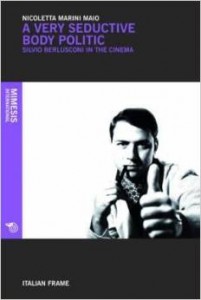Nicoletta Marini-Maio
Dickinson CollegeA Very Seductive body Politic: Berlusconi in Cinema
A Very Seductive body Politic: Berlusconi in Cinema
Mimesis International – Italian Frame
“In film, Berlusconi’s body is represented in a number of ways: as a disembodied figure in Il Caimano (The Caiman, 2006), as an allegory of pleasure in Viva la libertà (Long Live Libety, 2013), as a Kurtz-Brando metaphor in Shooting Silvio (2006), as an expressionless puppet in Ops… Ho ammazzato Berlusconi (Oops… I Killed Berlusconi, 2008), as a trigger for political self-reflection in Arance e martello (Oranges and Hammer, 2014), as a symbolic presence in Sorelle d’Italia (Sisters of Italy, 2010), as a well-connected Mafia member in La Trattativa (State-Mafia Pact, 2014), and as a catalyst of existential failure in Belluscone. Una storia siciliana (Belluscone. A Sicilian Story, 2014). Even Berlusconi’s mediated image has acquired unforeseen symbolic meanings, as seen in Berlusconi’s spectral image of power in La bella addormentata (Dormant Beauty, 2012), or in the self-referential icons of Silvio Forever (2011). This is only a partial list, but it is emblematic of the ways in which cinema captures and questions the tension between Berlusconi’s body and the meanings that we, the ‘interpretive communities’ (Fish 1982: 168), produce and assign to it. These films explore complex symbolic spaces in which cultural traditions, sense of belonging, desires, and existential objectives shift. […] In this sense, the appearance of Berlusconi in films is constructed as a polysemic image that lies in the eyes of the beholder. On the one hand, these films may appear as the result of an urge to explain, uncover, and denounce the hegemonic media and political power that Berlusconi incarnates. On the other hand, they reveal a strong fascination — almost an obsession — with Il Cavaliere (The Knight).”
This volume maps the multilayered narratives created in cinema on and around Silvio Berlusconi as a means of exploring the age of Berlusconismo. The analysis crosses chronological and generic boundaries, stretching back to the comedy Italian style, which foreshadows the symbolic meanings incarnated by Berlusconi before he actually entered the public stage. The book delineates a comprehensive cinematic corpus and focuses on a selection of narrative and documentary films, from the proto-Berlusconi everyman of La più bella serata della mia vita (The Most Wonderful Evening of My Life, 1972) by Ettore Scola, to the Berlusconi pretext for political self-reflection of Arance e martello (Oranges and Hammer, 2014) by Diego Bianchi. The author argues that the Berlusconi in these films represents not only the historical persona, but also a pervasive semiotic category in which the recent history of the country is inscribed and Italian society mirrors itself.
No comments yet »
Your comment
You must be logged in to post a comment.